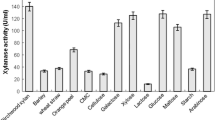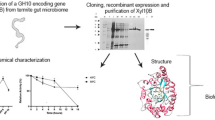Abstract
Xylanase is an enzyme in high demand for various industrial applications, such as those in the biofuel and pulp and paper fields. In this study, xylanase-producing microbes were isolated from the gut of the wood-feeding termite at 50°C. The isolated microbe produced thermostable xylanase that was active over a broad range of temperatures (40–90°C) and pH (3.5–9.5), with optimum activity (4,170 ± 23.5 U mg−1) at 60°C and pH 4.5. The enzyme was purified using a strong cation exchanger and gel filtration chromatography, revealing that the protein has a molecular mass of 205 kDa and calculated pI of 5.38. The half-life of xylanase was 6 h at 60°C and 2 h at 90°C. The isolated thermostable xylanase differed from other xylanases reported to date in terms of size, structure, and mode of action. The novelty of this enzyme lies in its high specific activity and stability at broad ranges of temperature and pH. These properties suggest that this enzyme could be utilized in bioethanol production as well as in the paper and pulp industry.






Similar content being viewed by others
References
Anonymous (2007) Termite guts may yield novel enzymes for better biofuel production. In: ScienceDaily 25 Nov. Available at: http://www.sciencedaily.com-/releases/2007/11/071121145002.htm. Accessed: 21 Apr 2010
Anonymous (2007) Biofuels: bringing biological solutions to energy challenges. US Department of Energy Office of Science, Washington D.C.
Bataillon M, Cardinali APN, Castillon N, Duchiron F (2000) Purification and characterization of a moderately thermostable xylanase from Bacillus sp. strain SPS-0. Enzyme Microb Technol 26:187–192
Beg QK, Kapoor M, Mahajan L, Hoondal GS (2001) Microbial xylanases and their industrial applications: a review. Appl Microbiol Biotechnol 56:326–338
Biely P (1985) Microbial xylanolytic systems. Trends Biotechnol 3:286–290
Breccia JD, Sineriz F, Baigori MD, Castro GR, Hatti-Kaul R (1998) Purification and characterization of a thermostable xylanase from Bacillus amyloliquefaciens. Enzyme Microb Technol 22:42–49
Brennan YL, Callen WN, Christoffersen L, Dupree P, Goubet F, Healey S et al (2004) Unusual microbial xylanases from insect guts. App Environ Microbiol 70:3609–3617
Brune A (2007) Woodworker’s digest. Nature 450:487–488
Cho MC, Bai S (1997) Purification and characterization of xylanase from Bacillus sp. strain DSNC 101. J Microbiol Biotechnol 7:386–390
Collins T, Gerday C, Feller G (2005) Xylanases, xylanase families and extremophilic xylanases. FEMS Microbiol Rev 29:3–23
Cordeiro CAM, Martins MLL, Luciano AB, da Silva RF (2002) Production and properties of xylanase from thermophilic Bacillus sp. Braz Arch Biol Technol 45:413–418
Dheeran P, Kumar S, Jaiswal YK, Adhikari DK (2010) Characterization of hyperthermostable α-amylase from Geobacillus sp. IIPTN. Appl Microbiol Biotechnol 86:1857–1866
Ikai AJ (1980) Thermostability and aliphatic index of globular proteins. J Biochem 88:1895–1898
Johnvesly B, Virupakshi S, Patil GN, Ramalingam A, Naik GR (2002) Cellulase-free thermostable alkaline xylanase from thermophilic and alkalophilic Bacillus sp. JB-99. J Microbiol Biotechnol 12:153–156
Ko CH, Lin ZP, Tu J, Tsai CH, Liu CC, Chen HT, Wang TP (2010) Xylanase production by Paenibacillus campinasensis BL11 and its pretreatment of hardwood kraft pulp bleaching. Int Biodet Biodeg 64:13–19
Ko CH, Tsai CH, Tu J, Yang BY, Hsieh DL, Jane WN, Shih TL (2011) Identification of Paenibacillus sp. 2S–6 and application of its xylanase on biobleaching. Int Biodet Biodeg 65:334–339
Kulkarni N, Shendye A, Rao M (1999) Molecular and biotechnological aspects of xylanases. FEMS Microbiol Rev 23:411–456
Kumar S, Singh SP, Mishra IM, Adhikari DK (2009a) Ethanol and xylitol production from glucose and xylose at high temperature by Kluyveromyces sp. IIPE453. J Ind Microbiol Biotechnol 36:1483–1489
Kumar S, Singh SP, Mishra IM, Adhikari DK (2009b) Recent advances in production of bioethanol from lignocellulosic biomass. Chem Eng Technol 32:517–526
Laemmli UK (1970) Cleavage of structural proteins during the assembly of the head of bacteriophage T4. Nature 227:680–685
Lee TH, Lim PO, Lee YE (2007) Cloning characterization and expression of Xylanase A gene from Paenibacillus sp. DG-22 in Escherichia coli. J Microbiol Biotechnol 17:29–36
Lin LL, Thomson JA (1991) An analysis of the extracellular xylanases and cellulases of Butyrivibrio fibrisolvens H17c. FEMS Microbiol Lett 84:197–204
Lineweaver H, Burk D (1934) The determination of enzyme dissociation constants. J Am Chem Soc 56:658–666
Liu CJ, Suzuki T, Hirata S, Kawai K (2003) The processing of high-molecular-weight Xylanase (XynE, 110 kDa) from Aeromonas caviae ME-l to 60-kDa xylanase (XynE60) in Escherichia coli and purification and characterization of XynE60. J Biosci Bioeng 95:95–101
Lopez-Fernandez CL, Rodriguez J, Ball AS, Copa-Patino JL, Perez-Leblic MI, Arias ME (1998) Application of the affinity binding of xylanases to oat-spelt xylan in the purification of endoxylanase CM-2 from Streptomyces chattanoogensis CECT 3336. Appl Microbiol Biotechnol 50:284–287
Lowry OH, Rosebrough AJ, Farr AL, Randall RJ (1951) Protein measurement with the Folin phenol reagent. J Biol Chem 193:265–273
Matson E, Ottesen E, Leadbetter J (2007) Extracting DNA from the gut microbes of the termite (Zootermopsis nevadensis). J Vis Exp 4:195
Matsui T, Tokuda G, Shinzato N (2009) Termites as functional gene resources. Recent Patents Biotechnol 3:10–18
Miller GL (1959) Use of dinitrosalicylic acid reagent for determination of reducing sugars. Anal Chem 31:426–428
Ninawe S, Kuhad RC (2005) Use of xylan-rich cost effective agro-residues in the production of xylanase by Streptomyces cyaneus SN32. J Appl Microbiol 99:1141–1148
Pason P, Kyu KL, Ratanakhanokchai K (2006) Paenibacillus curdlanolyticus strain B-6 xylanolytic—ellulolytic enzyme system that degrades insoluble polysaccharides. Appl Environ Microbiol 72:2483–2490
Schäfer A, Konrad R, Kuhnigk T, Kämpfer P, Herte H, König H (1996) Hemicellulose-degrading bacteria and yeasts from the termite gut. J Appl Microbiol 80:471–478
Shi P, Tian J, Yuan T, Liu X, Huang H, Bai Y, Yang P, Chen X, Wu N, Yao B (2010) Paenibacillus sp. strain E18 bifunctional xylanase-glucanase with a single catalytic domain. Appl Environ Microbiol 76:3620–3624
Varma A, Kollia BK, Paula J, Saxenaa S, König H (1994) Lignocellulose degradation by microorganisms from termite hills and termite guts: a survey on the present state of art. FEMS Microbiol Rev 15:9–28
Wang CY, Chan H, Lin HT, Shyu YT (2010) Production, purification and characterization of a novel halostable xylanase from Bacillus sp. NTU-06. Ann Appl Biol 156:187–197
Warnecke F, Luginbühl P, Ivanova N, Ghassemian M, Richardson TH, Stege JT et al (2007) Metagenomic and functional analysis of hindgut microbiota of a wood-feeding higher termite. Nature 450:560–565
Yin LJ, Lin HH, Chiang YI, Jiang ST (2010) Bioproperties and purification of xylanase from Bacillus sp. YJ6. J Agric Food Chem 58:557–562
Acknowledgments
All of the authors thank Dr M.O. Garg, Director IIP, Dehradun for his valuable suggestions and encouragement to carry out this research and also acknowledge their thanks to TCGA, New Delhi for the internal amino acid sequencing using LC–MS/MS. One of the authors gratefully acknowledges a Senior Research Fellowship awarded by the Council of Scientific and Industrial Research (CSIR), India.
Author information
Authors and Affiliations
Corresponding author
Rights and permissions
About this article
Cite this article
Dheeran, P., Nandhagopal, N., Kumar, S. et al. A novel thermostable xylanase of Paenibacillus macerans IIPSP3 isolated from the termite gut. J Ind Microbiol Biotechnol 39, 851–860 (2012). https://doi.org/10.1007/s10295-012-1093-1
Received:
Accepted:
Published:
Issue Date:
DOI: https://doi.org/10.1007/s10295-012-1093-1




